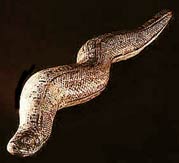
The Diaguita economy was based on agriculture and livestock breeding, supplemented with some large bird hunting and trade among villages.
They cultivated corn, teak, beans and pumpkins. They domesticated llamas and guanacos; animals that were very useful as a means of transporting cargo.
Their houses were built with vegetable materials, and to divide the land they used stone walls, of Atacameño influence, known as pircas.
Different grave-styles speak about their spiritual evolution and about their belief in a supernatural life and in divinities.
Basically, their burial sites consist on a rectangular enclosure, excavated below ground level, with two inclined stone blocks in order to protect the corpse. Also, some of them suggest that wives were buried next to their husbands. Such a tradition may have been a way of achieving balance between sexes.
Men and women were short in size, with clear olive colored skin. Their cranial deformation, a common practice among the Diaguita, did not produce unattractive or negative effects.